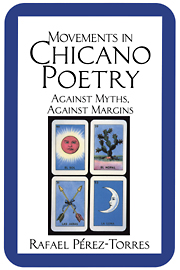Book contents
- Frontmatter
- Contents
- Acknowledgments
- 1 Introduction: Movements in a “Minority” Literature
- PART I THE POSTCOLONIAL
- 2 Four or Five Worlds: Chicano/a Literary Criticism as Postcolonial Discourse
- 3 From the Homeland to the Borderlands, the Reformation of Aztlán
- 4 Locality, Locotes, and the Politics of Displacement
- PART II THE POSTMODERN
- PART III CONFLUENCES
- Notes
- Works Cited
- Index
- CAMBRIDGE STUDIES IN AMERICAN LITERATURE AND CULTURE
2 - Four or Five Worlds: Chicano/a Literary Criticism as Postcolonial Discourse
Published online by Cambridge University Press: 17 September 2009
- Frontmatter
- Contents
- Acknowledgments
- 1 Introduction: Movements in a “Minority” Literature
- PART I THE POSTCOLONIAL
- 2 Four or Five Worlds: Chicano/a Literary Criticism as Postcolonial Discourse
- 3 From the Homeland to the Borderlands, the Reformation of Aztlán
- 4 Locality, Locotes, and the Politics of Displacement
- PART II THE POSTMODERN
- PART III CONFLUENCES
- Notes
- Works Cited
- Index
- CAMBRIDGE STUDIES IN AMERICAN LITERATURE AND CULTURE
Summary
[We] have in the Negro the embodiment of a past tragic enough to appease the spiritual hunger of even a James; and we have in the oppression of the Negro a shadow athwart our national life dense and heavy enough to satisfy even the gloomy broodings of a Hawthorne. And if Poe were alive, he would not have to invent horror; horror would invent him.
– Richard WrightBecause “-” in “Mexican-American” suggests both a (linguistic) bridge and a (mathematical) absence, it serves as an apt marker for the condition of Chicano literary criticism. This criticism attempts to bridge the discontinuities of its position at “the borderland,” to construct – out of a terrain that both is and is not either fully Mexican or fully American – some sense of place and belonging. Chicano literary criticism as a cultural project attempts to forge identity out of rupture. This identity rests on bridges between the Mexican and the American, between Spanish and English, First World and Third World, insider and outsider. Chicano literary criticism bridges the numerous borders placed around the Chicano by dominant discursive practices that separate and erase a continued history of resistance to repression.
It also maps the contours of a culture traced by a history of aggressive expansionism and inner-colonialism (forming a part of a larger and more inclusive atlas with other “Third World” and postcolonial positions). In so doing, it negotiates through a critical process that both replicates and refuses the same segregation, violence, and erasure it has endured.
- Type
- Chapter
- Information
- Movements in Chicano PoetryAgainst Myths, against Margins, pp. 23 - 55Publisher: Cambridge University PressPrint publication year: 1995



